#Buddhist bells
Explore tagged Tumblr posts
Text

Got so mad seeing a forced marriage plot for the 20th time that I got up to draw a design specifically to put a veil on him
#like not to victim blame but you’d think after the tenth time this happens covering up would just be more convenient#rip xuanzang you woulda loved face masks 🕊️#can’t believe he’s canonically such an irresistible pretty boy#I think I watched like two back to back marriagenapping plots and was flabbergasted#season 2 has so many of em…#whenever they start getting real close and touchy with him I get uncomfortable 😭#like girl does it have to be the MONK#surely he’s not the ONLY handsome dude you have access to!!!#they’re like all princesses or demon queens like you have OPTIONS boo 💀#damn put this boy in a veil the way he keeps getting bridenapped#I tried to make him look as tender and chewy as possible enjoy#he’s got the consistency of mochi I imagine 🤤#crap now I want to eat him…#digital art#my art#journey to the west#journey to the west fanart#jttw tripitaka#xuanzang#jttw sun wukong#big fan of his little face there#recognizing another bride plot coming up#put that hat back on or so help me!!!#I’m not drawing that nine ringed staff tf I look like an overachiever?? 🤨#I like the design but not satisfied with the way I executed it ya know?#I’m not Buddhist so do lemme know if any aspect of the design is disrespectful or wrong#feel like there should be more but I didn’t wanna go overboard but maybe I should’ve..#like ribbons and bells hanging off
127 notes
·
View notes
Text
Im sure someone made the joke already but having eichi fs2 with red and green, and keito event with obvious buddhist imagery at the beginning of december was very "it's gonna be christmas soon keito" "so what eichi" of happyele
#the joke is overdone atp i feel like ppl forget what exactly makes it funny but happyele remembered#the thing thats funny IS keito being buddhist. from a temple family. he doesnt gafff about jesus christs birth thats not his god#anyway. we should hype jingle bells up more when christmas is closer#the prologue...the card...one of the best christmas moments imo#oooh and starfes...thats also so good
82 notes
·
View notes
Photo

Joya no Kane (除夜の鐘) at Zojoji Temple, Tokyo, Japan
Japanese people consider December 31st a very important day, and it's not unusual for people of all ages to stay up all night on this occasion. Buddhist temples chime out 108 bells in-between New Year's Eve and New Year Day. According to Buddhist beliefs, 108 is the number of passions and desires entrapping us in the cycle of suffering and reincarnation. So, the 108 bell chimes symbolise the purification from the 108 delusions and sufferings accumulated in the past year. Many of the temples have bells of their own, and the starting time differs. Usually, you will start hearing the bell ring from 8-10pm on the 31st, and 107 of them will ring during the old year. Oftentimes, onlookers will line up for the chance to sound one of the chimes on the bell. The last 108th bell will be rung on the moment the New Year begins, and people listen to the bell until the last vibration stops.
#Japanese Culture#Japan#Joya no Kane#New Year's Eve Bell#除夜の鐘#Zojoji Temple#Tokyo#Buddhist Temple#New Year#Night#Zen Buddhism#Winter Events#Nippon#Japanese Tradition#Omisoka
10 notes
·
View notes
Text
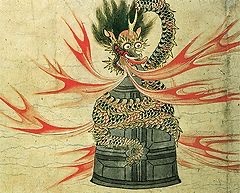
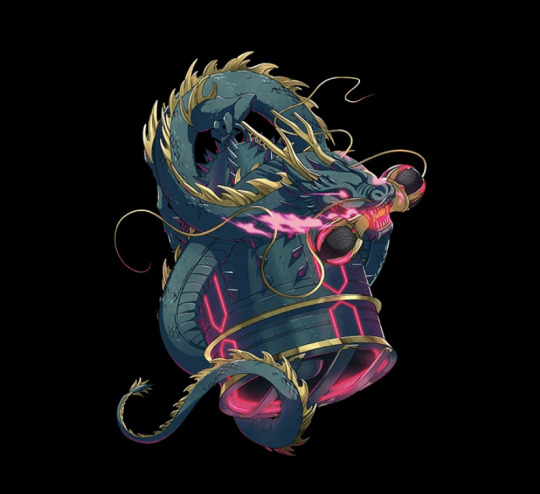
this artistic rendition of kiyohime makes me happy lmao
#vee queued to fill the void#so like i’ve been thinking#what if kuukou and jyushi’s speakers carry that ominous chuuoku pink because it’s an allusion to the women in their lives??#like pink at this point is synonymous to women in this series lol#eg ramuda being a chuuoku spy honobono with her pink hair flaunts her femininity#like i mentioned forever ago jyushi’s speakers are of a graveyard with amanda as the protective angel#and jyushi’s grandma *gestures* yeah you know#so then we have kuukou’s 🤔#while i’m still of the opinion his speakers also are a manifestation of himself with the buddhist concepts of wisdom and compassion#maybe similar to the kiyohime story where she trapped the monk in the bell#there’s a lady who had a huge influence in kuukou’s life he’s keeping very close to heart???#like kiyohime flew into a rage and turned into a dragon to chase her love (and kill him for leaving her lol)#kuukou the dragon of bad ass temple just might be of a similar mindset but i think that person probably left him for good (abandoned? 🤔)#and with the pink i’d assume it was a woman#hhhhhhhhhh there’s still more connections between his a jyushi’s speakers i wanna make (GHOSTS!!!!!! SPIRITS!!!!!!!! WHY ARE WORDS HARD!!!!#but i need to like sort them out in my brain better lol#c: kuukou👑
14 notes
·
View notes
Text


Nahida redesign! Breakdown below
So I adore Nahida as character, but especially as a southasian I always wished she would have more cultural motifs in her design. I really wanted to see something that could be realistically in the game, that adds to the original, while retaining the few great details hyv put in her design so I thought why not do it myself!
I based her dress on the lehenga instead of having the basic dress, as it's closest to her silhouette (missed opportunity!!!!!!). Its traditional wear, yet not as ancient as the saree which i thought fits nahidas youthfulness. Tbh I just split the dress in 2 lol, as i love her patterns


These prominently feature the bodhi leaf, which in buddhism symbolizes enlightenment and wisdom. So it was important for me to not alter those elements, and I changed almost nothing else on the dress.

What I did change are the sleeve things (?) To an actual dupatta, which is a type of long scarf. Put even more bodhi symbols there. Sorry for bad pic


Additionally I added a maang tikka (head jewelry) and earrings. I kept her bangle and the ghanta bell (used in hindu rituals) on the back as these are the other cultural elements she has.
The Mehndi design is a Lotus to reference one of her inspirations: Anahita, persian goddess of wisdom and flowing waters and where Nahida's name comes from. She is also inspired by hindu goddesses like Saraswati (also goddess of wisdom and more), Aranyani (forest goddess) , a forest fairy from the buddhist Kusanali Jataka tale, and likely even more.
And for the last detail: I gave her anklets, in reference to Aranyani/Rukkhadevata.

One of Rukkhadevatas title was Queen Aranyani, and the actual real goddess is said to have worn anklets with bells that were heard in the forest. Tho I removed the bells, since Rukkhadevata is dead and forgotten now, and so you can't hear her anymore. :')
Bc of it's purpose it's not the flashiest design, but I had so much fun researching, learning so many new things and trying to incorporate them back to Nahidas design! If someone educated has more to add or something I can correct I'd love to hear :)
4K notes
·
View notes
Text
Resonating Tranquility: Exploring Buddhist Prayer Wheel and Singing Bell Wholesalers
In the heart of the bustling modern world, where chaos often reigns supreme, the search for serenity and spiritual connection is a pursuit that holds eternal appeal. This pursuit finds its perfect companions in the form of Buddhist Prayer Wheel Wholesalers and Buddhist Singing Bell Wholesalers, as curated by Nepal Bazaar Trade.
https://justpaste.it/3kd6u
0 notes
Video
youtube
Unlock Divine Serenity: Buddhist Temple Bell Sound Meditation for Transc...
#youtube#Unlock Divine Serenity: Buddhist Temple Bell Sound Meditation for Transcendence & Inner Harmony divineserenity buddhist templebell bellsound
0 notes
Text
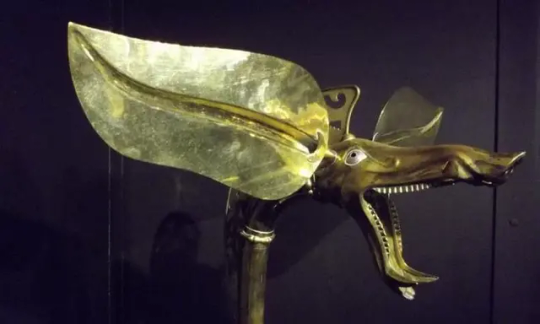

The 'Carnyx' Nightmare of the Roman Soldiers
The Carnyx was a brass musical instrument used as a psychological weapon of war by the ancient Celts between 300 BC and 200AD in western and central Europe and beyond.
The carnyx was once widespread throughout much of Europe, although only a dozen or so fragments are known to us.
It was carried by bands of Celtic mercenaries; it was present at the attack on the Greek sanctuary at Delphi in 279 BC; it defied Julius Caesar in Gaul; and it faced Claudius when he invaded Britain. They are even shown on a Buddhist sculpture in India, proof of the far-flung connections of the Iron Age world.
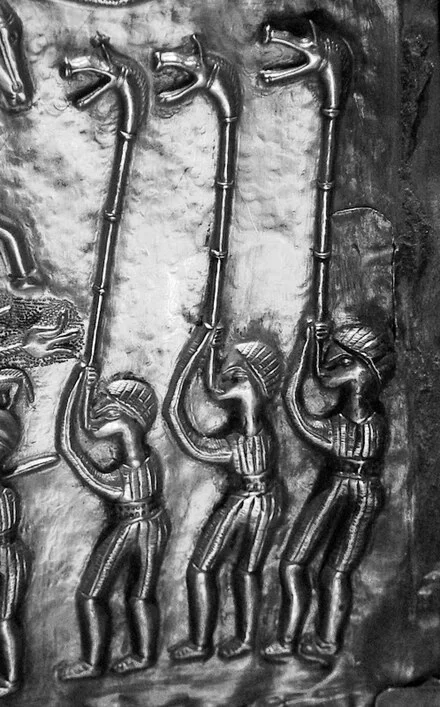
However, they were not only used by the Celts; they were also used by the Dacians in modern Romania. The term “Celtic” is a complicated one. The concept of a pan-European Celtic culture is a myth; rather, aspects of art and technology were shared across vast distances by diverse cultures. The carnyx was one example of this.
A 12-foot-long, thin bronze tube with right-angle bends on both ends made up the carnyx. The lower end ended in a mouthpiece, and the upper end flared out into a bell that was usually decorated to look like a wild boar’s had. Historians believe it had a tongue that flapped up and down, increasing the noise made by the instrument. The carnyx was played upright so that the boar’s head bell protruded well above the warriors’ heads. Its primary goal was to create more noise and confusion on the battlefield.
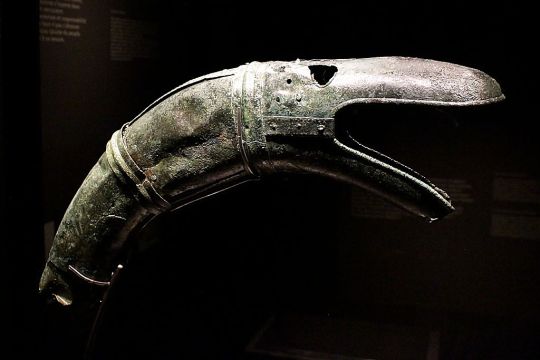
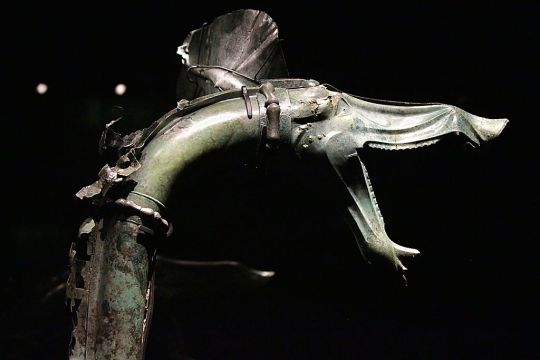
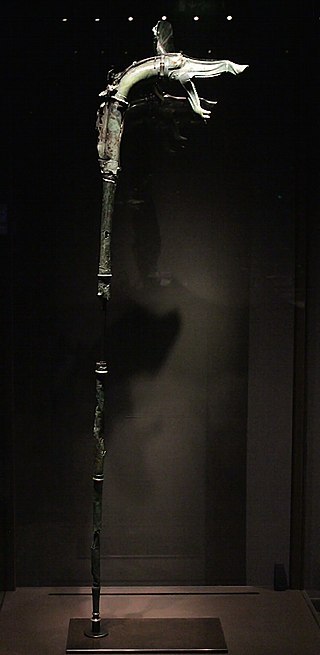
The Greek historian Polybius (206-126BC) was so impressed by the clamor of the Gallic army and the sound of the carnyx, he observed that “there were countless trumpeters and horn blowers and since the whole army was shouting its war cries at the same time there was such a confused sound that the noise seemed to come not only from the trumpeters and the soldiers but also from the countryside which was joining in the echo”.
And the Roman historian Diodorus Siculus wrote, “Their trumpets are also of a peculiar and barbaric kind which produce a harsh, reverberating sound suitable to the confusion of battle.”
Archaeologists discovered a hoard of ritually destroyed weapons in 2004, including a dozen swords, scabbards, spearheads, a shield, bronze helmets, an iron helmet shaped like a swan, a cauldron, animal remains, and seven carnyces. Before the Tintignac discovery, the remains of only five actual carnyces had been found.
The finest was unearthed in Deskford, Scotland in 1816. The Deskford carnyx only has the boar’s head bell and is missing the mane, tongue, and tubing. Images of Carnyx players have been found as well. A Roman denarius, dating from 48 BC bears a representation of a Carnyx. Three carnyx players are featured prominently on the Gundestrup Cauldron, which was found in a Danish peat bog.
One of the seven found at Tintignac, on the other hand, was almost entirely complete. The Tintignac Carnyx was broken into 40 pieces. When puzzled back together, it was found to be just an inch short of six feet long with a single missing section of the tube. The bell was a boar’s head with protruding tusks and large pointed ears. Once restored, the Tintignac Carnyx proved to be the first virtually complete carnyx ever found.
By Leman Altuntaş.
Music video by John Kenny.
#The Carnyx#The 'Carnyx' Nightmare of the Roman Soldiers#Iron Age war trumpet#ancient artifacts#archeology#archeolgst#history#history news#ancient culture#ancient civilizations#celtic mythology#celtic history#roman history#roman empire#roman legion
3K notes
·
View notes
Text
Chinese musical instruments pt. 1


I was inspired by my research into the different types of Chinese opera, so I decided to write about the chinese musical instruments.
Usually, traditional chinese instruments are grouped into 8 categories, 八音 (bā yīn): metal, bamboo, wood, stone, silk, clay, gourd and skin so I'll try to group them accordingly.
Metal 金 (Jīn)
Bo 钹 (bó) This is a percussion type of cymbal, with the size varying on the subtype. This instrument is also used in some chinese operas, which makes it all the more interesting to hear.
Bianzhong 编钟 (biānzhōng) This is a set of bronze chime bells, arranged in a specific order with each bell having it's own two special pitches which are usually determined by the bell size. The structure is especially interesting, as all the bells are hung from a frame (typically wooden) from which they're played. Other countries also have similar instruments, such as Japan, Vietnam and Korea although their names vary and they may have their own specific features.
Luo 锣 (luó) Luo is actually a general name for a gong, which varies in size and pitch depending on its type. Depending on the size, luo can either be hung on a frame or if it's small enough it can be played in hand.



Yunluo 云锣 (yúnluó) Like the luo, these are also gongs, named cloud gongs. There are 10 small gongs in a frame with the same size but different thickness so that each gongs pitch would vary. There is a more modern version, which has over 20 gongs and is much larger in size.
Suona 唢呐 (suǒnà) The Suona is a double-reeded trumpet, with reed meaning a thin strip of material. As Suona is classified as a metal instrument, it's made from metal with the reed attached to it. It's actual origin is quite interesting, as some sources place the Suona all the way to the Jin dynasty (266-420), whereas some consider Suona's origin to be from outside of China.


Bamboo 竹 (Zhú)
Dizi 笛子(dízi) The Dizi is a Chinese flute, which has quite a lot of varieties, such as 梆笛 (Bāngdí). This flute is especially interesting as it's used in Chinese opera, Chinese folk music and also in Chinese orchestra. Depending on the region, different bamboo is used to create this instrument - Purple bamboo in the north and white in the southern regions, although other material can also be used, even jade.
Xiao 箫 (xiāo) This is a vertical flute, orginating from the Qiang people in ancient China. The material is usually bamboo, with black and purple bamboo considered to be the best type. There are also quite a few variations, such as the 北箫 (Běixiāo), 琴箫 (Qínxiāo) and 南箫 (Nánxiāo).


Paixiao 排箫 (páixiāo) The Paixiao is a type of a panflute, which has a noticeable difference from the western type, as the pipe holes are created via an angled cut or a notch.
Bili 筚篥 (bìlì) / 管 (guǎn) This is a double-reed pipe, which has a few names. Guan appears to be a general name for woodwind instruments, so if looking for this specific instrument, it should be searched using Bili. This instrument can be traced back to the Zhou dynasty, where it was used as a military instrument. Later it became a popular court and ritual instrument, but eventually lost it's court popularity. Instead, it's quite popular in folk music and in Peking Opera, especially for military scenes.
Xindi 新笛 (xīndí) The Xindi is a more modern type of Dizi (the name literally means a new flute), which first appeared in the 20th century. The xindi differentiates itself from the original dizi by it's additional 5 holes, allowing for lower tones which makes it quite important for the Chinese orchestra.



Wood 木 (Mù)
Muyu 木鱼 (mùyú) This is a wooden fish-shaped woodblock which is hit to create a beat during rituals, most commonly during Buddhist ceremonies, Muyu's name literally means a wooden fish, as it's origin stories are associated with fish, with one story claiming that a fish helped a monk but in turn asked him for a favour, which the monk promised to do but forgot. The fish became angry and splashed him into the water. The monk survived, but his notes were all ruined, which is why he made a wooden statue of the fish and beat it.
Yu 敔 (yǔ) On the topic of animals, this is a tiger-shaped hollow box with toothed edges on its back. Why a tiger? It may be because the tiger had a powerful association with strength and power, although I have yet to find a source confirming my theory.


Zhu 柷 (zhù) This is a wooden box that has an open middle, which is played by using a wooden stick to hit the inner bottom. This instrument is very rarely used nowadays, with the majority of Zhus being in museums and temples, but apparently they still remain in use in a few temples for ceremonies.
Paiban 拍板 (pāibǎn) The Paiban is clapper made of wooden or bamboo flat pieces. When it's played together with a drum, this combination is called a Guban 鼓板 (gǔbǎn), which is used quite often in various different music genres, such as Peking Opera, Yue Opera, Kunqu Opera and others.


#slavic roots western mind#chinese music#music#musical instruments#chinese musical instruments#traditional chinese instrument#china#chinese culture#trumpet#flute#笛子#dizi#拍板#柷#木#木鱼#箫#钹#编钟#锣#percussion#唢呐#云锣#排箫#管#pipe#新笛#xindi
131 notes
·
View notes
Text


Tantra is the science of transforming ordinary lovers into soul mates. And that is the grandeur of Tantra. It can transform the whole earth; it can transform each couple into soul mates. -Rajneesh
Yab-Yum Talon Abraxas
Yab-Yum (Tibetan meaning "father-mother") is a common symbol in the Buddhist art of India, Bhutan, Nepal and Tibet representing the male deity in sexual union with his female consort. Often the male deity is sitting in lotus position while his consort is sitting in his lap.
The symbolism is associated with Anuttarayoga tantra and, while there are various interpretations of the symbolism in the twilight language, the male figure is usually linked to compassion (karuṇā) and skillful means (upāya-kauśalya), while the female partner to 'insight' (prajñā).
The symbolism of union and sexual polarity is a central teaching Tantric Buddhism, especially in Tibet. The union is realised by the practitioner as a mystical experience within one's own body.
Yab-yum is generally understood to represent the primordial (or mystical) union of wisdom and compassion. In Buddhism the masculine form is active, representing the compassion and skillful means (upaya) that have to be developed in order to reach enlightenment. The feminine form is passive and represents wisdom (prajna), which is also necessary to enlightenment. United, the figures symbolize the union necessary to overcome the veils of Maya, the false duality of object and subject.
Yab-yum may also be represented through the aniconic signification of yantra and mandala. In Tibetan Buddhism, the same ideas are to be found concerning the bell and the dorje, which, like the yab-yum, symbolize the dualism that must be exceeded. The sacred Tantric practice leads to rapid development of mind by using the experience of bliss, non-duality, andecstasy while in communion with one's consort.
72 notes
·
View notes
Text
April 12, Xi'an, China, Daci'en Temple/大慈恩寺 and the Giant Wild Goose Pagoda/大雁塔 (Part 1 - Temple and Architecture):

Daci'en Temple is famous in popular culture mainly for one reason: the monk Xuanzang/玄奘, or the real person who inspired the character of Tang Sanzang/唐三藏 (sometimes translated as "Tripitaka") in the novel Journey to the West/西游记. Xuanzang was in charge of Daci'en Temple after he returned to China in 645 AD from his journey throughout Central Asia and India. More on him later.
The temple is also known for two more things, first is its importance to Chinese Buddhism, as the temple is considered the cradle of the Consciousness-Only School (weishizong/唯识宗) and the Dharma Characteristics School (faxiangzong/法相宗)(both are part of Chinese Mahayana Buddhism), and second is the Giant Wild Goose Pagoda (built in 652 AD while Xuanzang was in charge of the temple).
The temple has been rebuilt over the years, and the current temple (excluding the pagoda) was mainly built in 1466, during Ming dynasty, thus the current temple consists of Ming-era architecture:


Drum and bell towers within the temple


Giant Wild Goose Pagoda in the distance

More pictures of the architecture. I have to say it's better preserved here than in other places so far...





Coming up to the Mahavira Hall/大雄宝殿 of the temple

As mentioned in the previous posts on Qinglong Temple, I avoided taking pictures of the Buddha statues as this is considered disrespectful. But because it's just hard to avoid including them in pictures of the architecture, the statues may be partially visible sometimes.


Approaching the Tushita Hall/兜率

More pics of the architecture, note the pattern on the windows, called chuangling/窗棂. This particular one is a "three-crossing"/三交 pattern, the highest grade of chuangling.
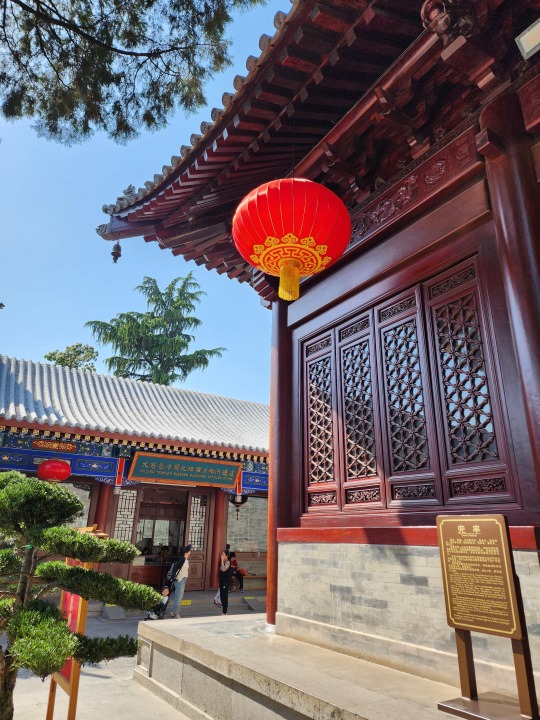

There were two visiting monks taking pictures of this relief behind Mahavira Hall, so it's probably okay to snap a picture of it. The interesting thing is the bian'e/匾额 above it, which says 人天欢喜 (right to left: "human and heaven rejoice together"). Usually it's "heaven" before "human" (天人), but here it's clearly "human" before "heaven".



The Guanyin Hall/观音殿. Guanyin is the Chinese name for Avalokitesvara. The smaller red lanterns are where visiters hang their wishes from:

And finally the Giant Wild Goose Pagoda, one of the landmarks of Xi'an. This pagoda was originally built to house all of the Buddhist texts and relics Xuanzang had brought back from India, and is the largest Tang-era brick pagoda remaining today. In Tang dynasty (618 - 907 AD), people who passed the imperial exams to become jinshi/进士 would tour around Chang'an on horseback with flowers in their hair and write poems before this pagoda, called "雁塔题名".
Before we entered the temple, I could hear a weird jingle-jangle from across the street, but it was only when we came up to the pagoda that I realized where the sound was coming from. There were bells hanging from every corner of every level of the pagoda, and they were pretty loud for their size.

Since it was pretty hot outside that day, to avoid possible heat stroke we didn't attempt to climb the pagoda (I don't think there's air conditioning inside considering that this pagoda is 1300+ years old.....). I think there were several important artifacts/relics inside? But I can find some pictures from online for part 3.



#2024 china#xi'an#china#daci'en temple#大慈恩寺#giant wild goose pagoda#大雁塔#xuanzang#玄奘#buddhist temple#chinese architecture#chinese history#mahayana buddhism#buddhism#architecture#history#culture
95 notes
·
View notes
Note
Hi, I’ve only read one meta by you yet, but you seem to be just the right person to ask this: did you notice how many people in the scenes outside the bookshop are wearing orange, in series 2?
Any idea what that’s all about? Is it just esthetics, an echo of the bookshop‘s columns, or does it have a filmographical significance? Everytime I watch the show there seem to be more orange clothes, once you start seeing that, it’s crazy how many there are!
Hey thanks for the ask! I mean, you have until 2026 to read more of my drivel so; pace yourself! Orange clothing is definitely an *interesting* choice for extras in film. You almost never see it in background actors clothing because... it draws the eye! The fact that they included so much orange, yellow, and loud patterning in the extras in season 2 is a real decision to throw film tradition and S1 cannon out the window.
I would like to submit my own theory that the choice was made as a deliberate nod to time travel. But first, a little background.
Compare two crowd scenes on Whickeber street from each season: It's kind of nuts that even at microscopic resolution we get such a HUGE difference.


That's not to say orange is missing. Here are the only two extras wearing orange in S1, and they happen to be in the same scene in episode 2, when Newt and Shadwell meet for the first time, discussing occult beings "hiding in plain sight". (witches in this case)
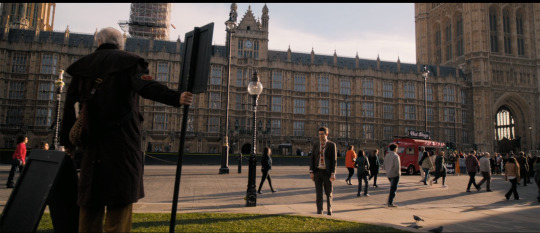
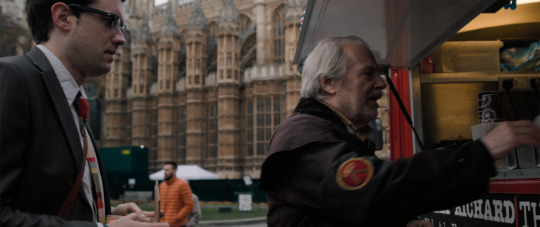
We also get some pretty obvious bright orange in main characters in S1: Madame Tracy and Beelzebub. We meet Tracy in orange as she immediately reveals to Newt multiple hidden identities, see her again wearing orange hair when she communes with spirits, and finally all decked out in orange when she is being possessed by an angel (a person hiding inside a person). Beelzebub wears an orange sash and medal as a high ranking Duke of Hell, so orange is maybe their house colour, or a prestigious colour for hell in general, but after season 2 we know Beelzebub doesn't always have the same face, and is hiding intentions of their own.

Orange doesn't have much biblical significance, mostly because the colour orange was mostly seen as "fire" or "bright" coloured until way after the bible was transcribed, and orange dye wasn't really a thing in the European world until significant trade with east Asia developed. Here's the only other bright orange thing to appear all season, (in a deleted scene): Crowley hiding in plain sight, posing as a maintenance worker.

I think we might be able to draw the conclusion from season 1 that orange is a colour associated with the "Hidden Occult/Power". Not necessarily only hell, but more as something otherworldly, that's hidden in plain sight. (Interestingly, we never ever see Anathema or Agnes Nutter in orange. So I wouldn't say it's related to witches at all.)
In season 2 however, orange is everywhere. More specifically on extras' clothing and the outside of Maggie's record shop.

Maggie seems to be the only main character to wear bright orange herself (E2).

But this is by far my favourite one: in the back of the crowd of demons getting a Shax pep talk in S2E5, there's a regular human extra wearing bright orange sitting amongst the army, completely unnoticed by both demons and audience, observing the plan.

This really set off alarm bells for me, because there's a very Terry Pratchett precedent for powerful and unnoticed orange-wearing characters in the discworld series : the time monks.

Terry's character Sweeper seen here on the original cover of Night Watch. The time monks' clothing and general philosophy is based on Thai buddhist monks, who (like in many buddhists sects) wear donated, saffron-dyed robes in orange and yellow/red to symbolize flames of purity, and to separate them from the world of gross matter, like a fallen leaf from a tree.
In the discworld novel Night Watch, the time monks are responsible for monitoring and cleaning up the timeline, pruning it like a bonzai tree. They are everywhere and yet unnoticed, inside the flow of time yet not of it. And they are the ones who guide the main character through the process of being stuck after falling back through his own timeline, into his own past.
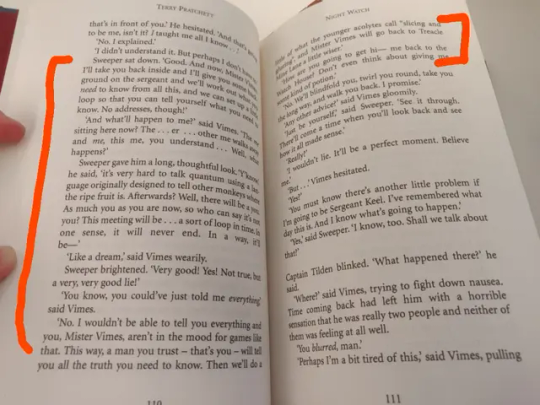
(Excerpt from the book where Sweeper is explaning time travel to Vimes).
Extras circling in the background are called "background actors" because they exist to not be noticed. Put in extras wearing orange/yellow and bright red, and suddenly you can track them, and notice how they are part of the crowd, but stand apart from it. You can notice when they go missing from one cut to the next, or appear to circle or jump between frames. Many extras, including the demon army watcher, also seem to be circling, and monitoring the goings-on in the world of Good Omens. Based on the meaning of orange from S1, it would seem these mere background actors are more than they appear to be. Could they even be checking up on unwarranted time distortions or timeline ruptures happening around a certain Bookshop...?
#good omens 2#art director talks good omens#good omens meta#go season 2#go meta#good omens season 2#good omens season two#good omens#go2#good omens analysis#good omens s2#good omens theory
130 notes
·
View notes
Text

Resonance of History: Gumyoji Temple's Belfry・桜と弘明寺の鐘楼堂
Location: Gumyoji, Minami Ward, Yokohama, Japan Timestamp: 18:47・2024/04/09
Fujifilm X100V with 5% diffusion filter ISO 160 for 20 sec. at ƒ/11 Classic Negative film simulation
In this long-exposure photo of the bell and belfry at Gumyoji Temple in Yokohama, Japan, I tried to capture the serene atmosphere of the temple grounds. This nighttime scene showcases the traditional Japanese architectural style of the belfry, with its large, curved roof and wooden beams. I especially like the cherry blossoms that are in full bloom in contrast with the bare branches of other trees, all subtly illuminated by ambient lighting.
The bronze bell hanging in the belfry, which was cast in 1798, is central to the Japanese Buddhist ceremony Joya-no-Kane held on New Year’s Even, where it is rung 108 times to symbolize the cleansing of 108 earthly desires accumulated over the past year.
Check out the full write-up here: https://www.pix4japan.com/blog/20240409-belfry (2-minute read), which also cites sources and a glossary.
55 notes
·
View notes
Photo

Buddhism in Ancient Korea
Buddhism, in Korean Bulgyo, was introduced by monks who visited and studied in China and then brought back various Buddhist sects during the Three Kingdoms period. It became the official state religion in all Three Kingdoms and subsequent dynasties, with monks often holding important advisory roles in governments. Korean Buddhism came to be much more inclusive than in other cultures with significant attempts made by important Buddhist scholars to reconcile the many diverging branches of the religion. Buddhism would have a profound influence on Korean art, literature, and architecture from bells to pagodas, ceramics, sculpture, and even developments in printing techniques.
Introduction From China
According to tradition, Buddhism was introduced first to the kingdom of Goguryeo (Koguryo) in 372 CE, followed by Baekje (Paekche) in 384 CE, and finally in the Silla kingdom between 527 and 535 CE. The first monk to bring Buddhist teachings was Sundo, who was sent for that purpose by the ruler of Eastern Qin, Fu Jian. It was hoped that stronger cultural ties with Goguryeo would lead to more practical cooperation in meeting the military threat posed by hostile Manchurian tribes. A decade later, Marananta, an Indian or Serindian monk, came from the Eastern Jin state and taught Buddhism in the Baekje kingdom. In both states, the new faith received a favourable reception. In the Silla kingdom, though, Buddhism was seen as a threat to the traditional religions of shamanism, animism, and ancestor worship, and not until the martyrdom of the monk Ichadon was Buddhism finally accepted and then promoted by the royal court.
Continue reading...
33 notes
·
View notes
Text
Contact online wholesalers for reliable Buddhist articles
Everyone knows about the existence of prayer wheels and their importance. They are the wheels initially used by the Tibetans to pray and thank God for blessings. They turn them to grab merit to cleanse their karmas and ward off all the negativities that surround them. With each turning the Buddhists monks used to chant mantras. They are famously known as Tibetan mani chos ‘khor, which were used at the religious places.
https://penzu.com/p/146e901b
0 notes
Text
SATORU GOJO

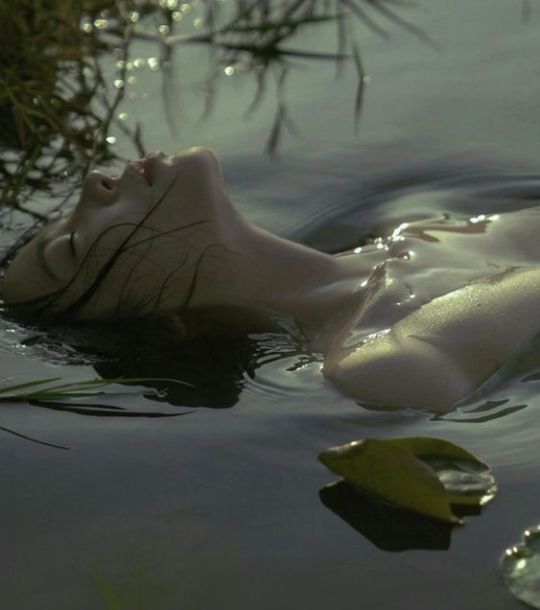
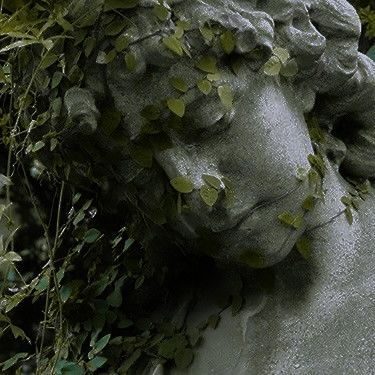
Goes With This (0)
Satoru thought you looked pretty cool when he initially found you. A total badass that slaughtered everything that terrorized her–he respected the ruthlessness.
And when you woke up and couldn't even sense the waves of cursed energy he was emitting at you, he was elated for some odd reason. You were clueless about the waves of energy you reciprocated, and Gojo essentially enrolled you into Jujutsu Tech.
"You think anything's special about her?" Suguru questioned him at their hotel before their flight back to Tokyo. You were in the other room, putting on one of the outfits Satoru went out to buy–all you had were the blood-stained rags you wore in captivity and the gown from the hospital.
"There's something about her cursed energy," Satoru answers sternly, trying to convince his friend of his suspicions. "I just have a feeling, y'know?"
"I suppose you might have some reference to what you're saying," Suguru refuses to admit to Satoru might be right.
There's a knock at their door, and Suguru goes to answer it.
"Hey, how does this look?"
Satoru gives you a glance, and his face quickly burns. You're standing at the entrance in a comfortable airport outfit with slippers and baggy fabric. He thinks you look amazing, but he bites his tongue before it can slip out.
"You look nice. Comfortable," Suguru tells you in a nonjudgemental tone, the sweetheart he is.
-
Later that night, Satoru believes he experienced sleep paralysis (but he eventually learns it was you). He sleeps in the same room as Suguru, but they occupy separate queen-size beds. He stirs with his limbs rigid against the side of his body. A wave of anguish washes through him, and he strains to turn his neck to the side and call out to Suguru, but only muted choked grunts make it past his lips.
A head is popping out beside his bed, looking from the edge and staring at him. It's a woman shrouded in shadow with beady eyes and long horns edging closer up the bed to him.
Satoru activates his Infinity before the woman can get too close and notices she's wearing a worn-out kimono.
She doesn't move any closer or mutter anything he can understand, but then she slinks away.
And when he wakes up later that morning, he realizes his memory of her face is distorted and he shudders at his recollection.
You don't seem to have a clue why Satoru's staring at you so hard when he eventually sees you for the flight.
-
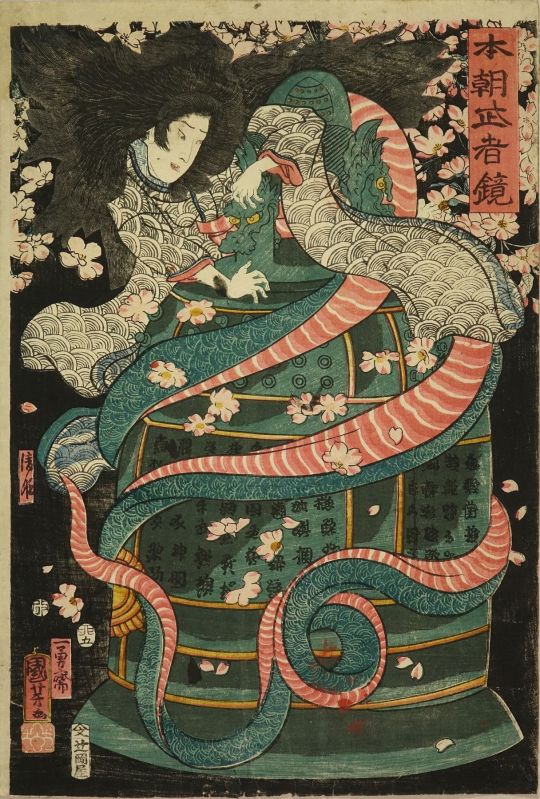
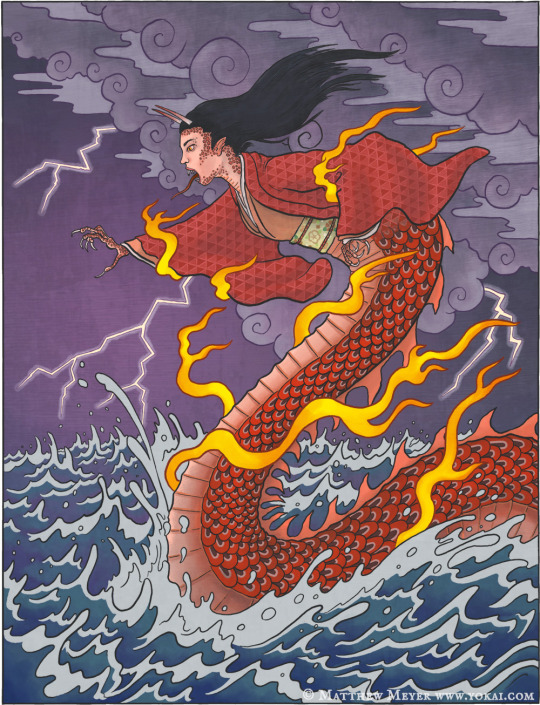

KIYOHIME
origin' A princess in Japanese folklore. She fell in love with a Buddhist monk named Anchin, but after her interest in the monk was rejected, she chased after him and transformed into a serpent in a rage before killing him in a bell where he had hidden in the Dōjō-ji temple.
#[muse] ichiyo tanaka#[fic] a thing of nightmares#gojo satoru x reader#gojou satoru x reader#jujutsu kaisen satoru#satoru gojo#gojo satoru#gojou satoru x you#satoru gojo fanfic#satoru gojo x you#gojo x you#gojo x reader#gojo jjk
181 notes
·
View notes